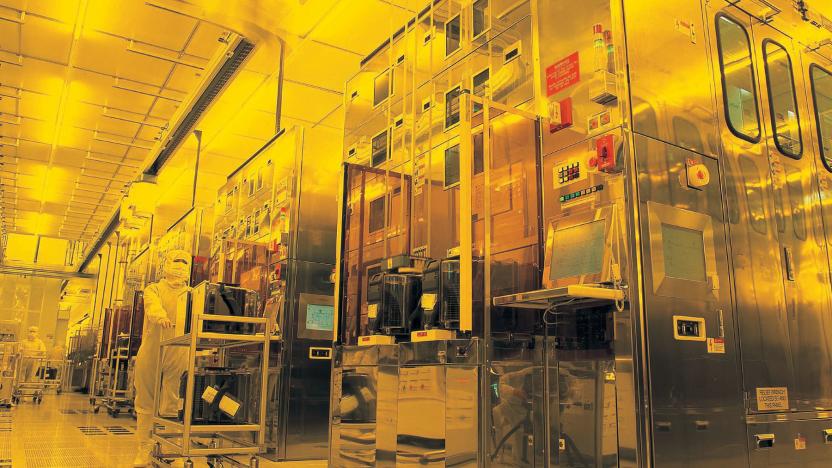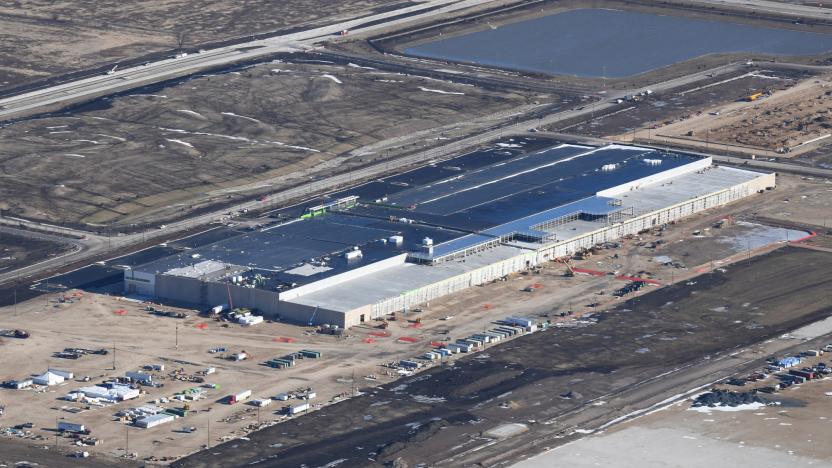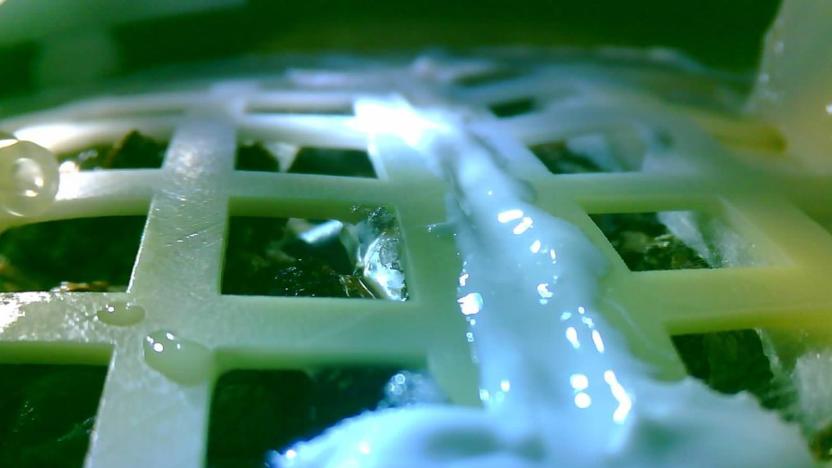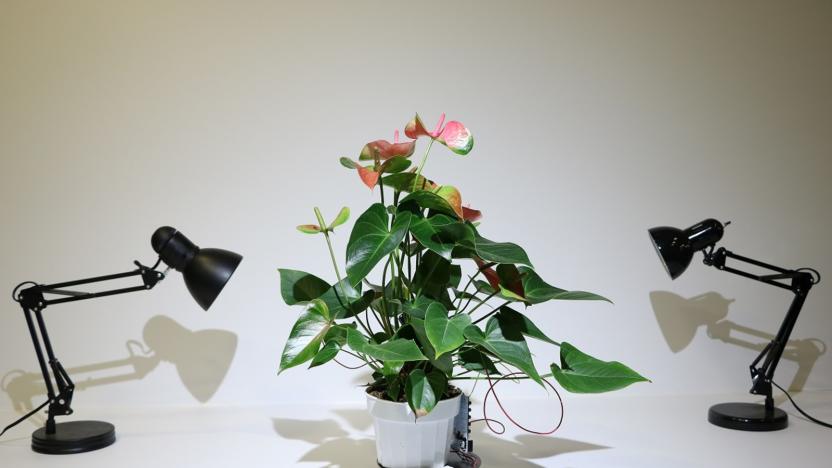plant
Latest

Samsung will build a $17 billion semiconductor factory in Texas
Samsung is building a new factory in Texas for advanced chips.

Rivian reportedly plans to invest $5 billion in its second US assembly plant
Rivian plans to invest $5 billion initially in a second manufacturing plant, dubbed Project Tera, with construction slated to start in the fall of 2021

Foxconn drastically scales back plans for $10 billion Wisconsin factory
After promising 13,000 new jobs in the state, Foxconn will only create 1,454 positions.

Apple chip-maker TSMC is building a $12 billion plant in Arizona
Taiwan Semiconductor Manufacturing Co. (TSMC), which manufactures processors and other chips for Apple, NVIDIA and many other firms, has confirmed that it will build a $12 billion chip fab plant in Arizona.

Foxconn's contentious Wisconsin plant will be used to make ventilators
Foxconn’s dubious Wisconsin factory will be used to produce ventilators to aid in treatment for COVID-19 around the US

Volkswagen begins pre-production of its ID.3 EV in China
Just days after Volkswagen showed off the first all-electric ID.3 produced at its Zwickau plant in Germany, the company announced that it has entered pre-production in China, too. Like the Zwickau factory, the new plant in Anti, Shanghai, will produce all-electric vehicles on Volkswagen's MEB platform, a modular design that's built for battery packs of varying sizes.

Honda will offset 60 percent of its US electricity use with wind and solar
Honda plans to cover 60 percent of the electricity used at its North American manufacturing plants with renewable energy. Beginning next fall, Honda will purchase 530,000 MWh per year from the Boiling Spring Wind Farm in Oklahoma. In fall 2021, it will begin receiving 482,000 MWh per year from a Texas solar facility. According to Honda, this deal is the largest single purchase of solar and wind power by any automaker.

China grows the first plants on the Moon
The greenery you see in the soil above might not look like much, but it represents a big step in space exploration. Cotton seeds brought to the Moon aboard China's Chang'e-4 mission have sprouted, marking the first time plants have grown on the lunar surface. They're not in contact with the lunar surface, as you might imagine. The cotton, potato seeds, yeast and fruit fly eggs are instead tucked inside a sealed, self-sustained biosphere that provides the necessary climate and nourishment.

MIT researchers create a robot houseplant that moves on its own
Despite our best intentions, keeping a houseplant alive can be a struggle for a lot of us. But that vague wave of sadness you feel when you end up unceremoniously dumping your potted pal in the bin is about to reach a new and slightly disturbing level, as researchers from MIT have found a way to use robotics to tap into plants' human-like characteristics.

Researchers create working electronics inside a rose
Plants and electronics frequently get along, but you don't see electronics in plants -- not surprisingly, it's hard to insert circuitry without killing the host. Swedish scientists just overcame one of the biggest hurdles to creating these strange cyborgs, however. They've successfully made the key elements of an electronic circuit inside of a rose and light up ions inside the flower's leaves. The trick was to insert a special polymer that self-assembled into wires throughout the stem, carrying electricity without cutting off the flow of life-giving nutrients.

Sensor-equipped plant pods take the guesswork out of indoor gardening
Have you been thinking about trying your hand at gardening, but lack the green thumb to keep those plants alive? There's a new Kickstarter project that may be able to lend a hand. Plug & Plant is a wall-mounted system of pods that not only neatly organizes the indoor plants, but each one is equipped with Bluetooth room, humidity and light sensors. That tech gathers data from the environment and offers tips for optimum plant growth. A Smart Water Tank also uses the collected info to vary the watering regimen as needed for up to 30 days. Details are beamed to a companion app that displays the stats for each senor independently as well as analyzes the data and providing suggestions for care.

Parrot's latest plant sensors can also do the watering for you
Following last year's Flower Power plant sensor, Parrot's decided to take it to the next level with two new Bluetooth Smart devices: the H2O and the Pot (pictured above). Starting off with the smaller device, the H2O is essentially a direct successor to the Flower Power, but featuring more accurate monitoring (of soil moisture level, soil fertility, temperature and brightness) and the new watering capability. The latter part is done so by attaching a screw-top water bottle of up to two liters, which will provide up to three weeks of autonomous irrigation with a soft jet. With the existing database of over 8,000 plants, the device can determine the optimal amount of water needed for your plant, and the companion app will remind you if more water or fertilizer is needed.

Edyn's smart gardening system gives your plants exactly what they need
Smart home gardening devices frequently tell you that your plants need a little TLC, but they don't always deliver it; you frequently have to bring out a hose or watering can. If Edyn successfully funds its smart garden system, you may not have to trudge out to the backyard quite so often. The core is a WiFi-connected sensor that detects both the soil quality and ambient conditions, cross-checking those against your choice of greenery. If the sensor decides that your plants need some hydration, Edyn's iOS app automatically tells an optional smart valve to deliver just the right amount of water-- yes, you can be waste-free and lazy. Both the sensor and valve combine solar power with lithium-ion batteries, so you don't have to worry about watering on cloudy days.

MIT designs a floating, tsunami-proof nuclear plant
What's the safest place to put a nuclear reactor? Offshore, apparently. A new power plant design concept from MIT envisions a facility built on floating platforms, moored in deep water several miles off the coast. This, the concept's creators explain, lends it several crucial advantages -- making it virtually immune to earthquakes, tsunamis and meltdowns. Big promises, to be sure, but the professors' reasoning actually makes sense: in deep water, tsunami waves aren't large enough to cause significant damage, and earthquakes are usually only felt if you're standing on the earth. Floating the reactor on the ocean also gives the plant access to easy, passive cooling, what MIT's Jacopo Buongiorno calls an "infinite heat sink."

MIT's bionic plants could be used as energy factories and sensors
In many ways, plants are ideal technology hosts -- they're outdoor-friendly, self-healing and pollution-free. It only makes sense, then, that MIT scientists want to harness that potential by augmenting our leafy friends with nanotechnology. The researchers have found that injecting nanoparticles and carbon nanotubes into a plant can extend its natural abilities, or add functions that would be tricky to replicate with purely synthetic devices. One lab test supercharged photosynthesis, extracting much more energy than normal; another introduced gas sensors that could detect the nitric oxide from a car's exhaust. There's a lot of necessary refinement before bionic plants are practical, but we won't be surprised if our gardens eventually double as energy sources and air quality monitors.

Home Lohas brings hydroponic gardening into your room, rabbit guard not included
While running between booths at Computex earlier this month, we were momentarily distracted by these vegetable boxes (maybe it was lunch time as well). As it turned out, this product was launched by Taiwan-based Home Lohas around the same time as when the expo started. The company pitches its hydroponic gardening appliance -- so the vegetables rely on nutritious water instead of soil -- as a hassle-free, low-power solution for growing your own greens, plus it's apparently the only solution in the market that doesn't need water circulation. With its full spectrum LED light, air pump and timers, harvest time can apparently be reduced by about 30 percent. It's simply a matter of filling up the water tank, adding the necessary nutrients and placing the seeded sponge on the tray (the package includes three types of organic fertilizers and some seeds). The only downside is that this system costs NT$15,800 (about US$530) in Taiwan, and for some reason, it'll eventually be priced at US$680 in other markets. If that's too much, then stay tuned for a half-size model that's due Q4 this year. %Gallery-191544%

University of Georgia stops plant photosynthesis to generate solar power
There's a more efficient way to harvest energy from the backyard than by wiring up hapless critters. Researchers at the University of Georgia have proof: they've discovered a way to generate electricity from plants through hijacking the photosynthesis process. By altering the proteins inside a plant cell's thylakoids, which store solar energy, scientists can intercept electrons through a carbon nanotube backing that draws them away before they're used to make sugar. While the resulting power isn't phenomenal, it's still two orders of magnitude better than previous methods, according to the university. The protein modification method may have a rosier future, as well: the team believes that it could eventually compete with solar cells, producing green energy in a very literal sense.

Bitponics personal gardening assistant eyes-on (video)
Plants need TLC just like any other living thing, but sadly, they're not really great at telling you what they want. Bitponics is looking to take a bit of that guess work out of hydroponic and aquaponic gardens with a WiFi base station that monitors your plant life and connects to automated accessories that help you care for them. The device ships with monitors for pH, water temperature, air temperature, humidity and light, connecting to the company's Bitponics Cloud system, so you can monitor things remotely via web browser. The system's not cheap -- it's set to run $499 when it ships, fittingly, this spring. Check out a video walkthrough of the setup just after the break.%Gallery-187330%

Parrot's Flower Power monitors plant's environment, sends data to the cloud
For a company that usually makes Bluetooth audio products and quadcopters, this sure is a weird product coming from Parrot, but we dig it (pun intended). The French company has announced its Flower Power at CES, and as you can probably guess from the name, 'tis a smart sensor that you can insert into a pot to monitor the plant's environmental variables: sunlight, humidity, temperature and fertilizer (but no acidity?). The data is sent to the cloud via Bluetooth Smart for analysis before coming back to your mobile device, and you'll be able to look up Parrot's "library of thousands of plants" for the extra care for your herbal friends. No price has been announced for the Flower Power just yet, but it'll definitely be out at some point this year. Update: Official video added after the break. Update 2: During our stage interview, Parrot CEO Henri Seydoux confirmed that that the Flower Power can also measure the soil's pH level, so all is good. Update 3: The pH detector has been removed from the final specifications. Sorry folks. Follow all the latest CES 2013 news at our event hub.

Riot breaks out at Foxconn's Taiyuan plant, reportedly over guards beating up a worker (update: confirmed)
News just came in that workers at Foxconn's Taiyuan plant have started a riot in the wee hours in China, and that police forces are on site to control the crowd. While the motive isn't clear, Sina Weibo user Li Tian reports that the riot isn't related to the recent anti-Japan protests, though judging by his photos, much damage has been done in the process. The same site suffered from a strike back in March over salary dispute -- the front-line workers failed to receive the promised pay rise. On a similar note, Foxconn's Chengdu plant also had a riot in June, but that was apparently due to an argument between some workers and a local restaurant owner. Update: We are seeing unofficial reports claiming the "2,000-people" riot was triggered by security guards hitting a worker at 10pm local time. Update 2: According to a provincial website, Foxconn's Taiyuan industrial park focuses on magnesium alloy components for consumer electronics, heat conduction products, LED lighting products, mobile phone products and magnesium alloy automotive components. Update 3: An undercover report from August mentioned that the Taiyuan plant processed the back casing of the iPhone 5. It also highlighted the company's harsh management as well as "practically compulsory" over-time work. We don't doubt that this riot escalated due to dissatisfaction over working conditions. Update 4: Unsurprisingly, the original Sina Weibo posts have since been deleted. At the time of publication, the author had already noticed that some of the photos were already being censored by Sina. However, the photos over at Baidu Tieba are still intact. Update 5: Well this is interesting. Foxconn has told Reuters that there was "a fight among workers from different production lines," but the company's spokesperson said they're "still investigating the cause of the fight and the number of people involved." An official statement will be released on Monday. Update 6: The Next Web has heard that there were no deaths in the incident. Here's hoping those 40 injured people will recover quickly. Update 7: Foxconn has told CNET that production has resumed today. Update 8: Reuters spoke to some employees who confirmed the fight between guards and workers. This wouldn't be the first time the two sides clashed in a Foxconn facility.









